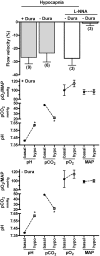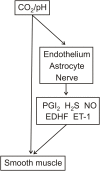pCO(2) and pH regulation of cerebral blood flow
- PMID: 23049512
- PMCID: PMC3442265
- DOI: 10.3389/fphys.2012.00365
pCO(2) and pH regulation of cerebral blood flow
Abstract
CO(2) serves as one of the fundamental regulators of cerebral blood flow (CBF). It is widely considered that this regulation occurs through pCO(2)-driven changes in pH of the cerebral spinal fluid (CSF), with elevated and lowered pH causing direct relaxation and contraction of the smooth muscle, respectively. However, some findings also suggest that pCO(2) acts independently of and/or in conjunction with altered pH. This action may be due to a direct effect of CSF pCO(2) on the smooth muscle as well as on the endothelium, nerves, and astrocytes. Findings may also point to an action of arterial pCO(2) on the endothelium to regulate smooth muscle contractility. Thus, the effects of pH and pCO(2) may be influenced by the absence/presence of different cell types in the various experimental preparations. Results may also be influenced by experimental parameters including myogenic tone as well as solutions containing significantly altered HCO(3) (-) concentrations, i.e., solutions routinely employed to differentiate the effects of pH from pCO(2). In sum, it appears that pCO(2), independently and in conjunction with pH, may regulate CBF.
Keywords: carbon dioxide; cerebral blood flow; nitric oxide; respiratory acidification; respiratory alkalinization; vasoactive factors.
Figures


Similar articles
-
Changes in p(i)CO(2) reflect splanchnic mucosal ischaemia more reliably than changes in pH(i) during haemorrhagic shock.Langenbecks Arch Surg. 2001 Aug;386(5):333-8. doi: 10.1007/s004230100230. Langenbecks Arch Surg. 2001. PMID: 11685563 Clinical Trial.
-
Resource allocation and extracellular acid-base status in the sea urchin Strongylocentrotus droebachiensis in response to CO₂ induced seawater acidification.Aquat Toxicol. 2012 Apr;110-111:194-207. doi: 10.1016/j.aquatox.2011.12.020. Epub 2012 Jan 21. Aquat Toxicol. 2012. PMID: 22343465
-
Bicarbonate concentration and osmolality are key determinants in the inhibition of CHO cell polysialylation under elevated pCO(2) or pH.Biotechnol Bioeng. 1999 Oct 20;65(2):182-91. doi: 10.1002/(sici)1097-0290(19991020)65:2<182::aid-bit8>3.0.co;2-d. Biotechnol Bioeng. 1999. PMID: 10458739
-
Integration of cerebrovascular CO2 reactivity and chemoreflex control of breathing: mechanisms of regulation, measurement, and interpretation.Am J Physiol Regul Integr Comp Physiol. 2009 May;296(5):R1473-95. doi: 10.1152/ajpregu.91008.2008. Epub 2009 Feb 11. Am J Physiol Regul Integr Comp Physiol. 2009. PMID: 19211719 Review.
-
Physiological mechanisms controlling cerebral blood flow.Stroke. 1980 May-Jun;11(3):240-8. doi: 10.1161/01.str.11.3.240. Stroke. 1980. PMID: 6771898 Review.
Cited by
-
Targeted temperature management and PbtO2 in traumatic brain injury.Brain Spine. 2023 Nov 14;3:102704. doi: 10.1016/j.bas.2023.102704. eCollection 2023. Brain Spine. 2023. PMID: 38105803 Free PMC article.
-
Neurovascular coupling: motive unknown.Trends Neurosci. 2022 Nov;45(11):809-819. doi: 10.1016/j.tins.2022.08.004. Epub 2022 Aug 19. Trends Neurosci. 2022. PMID: 35995628 Free PMC article. Review.
-
Normothermic Ex Vivo Machine Perfusion of Discarded Human Pancreas Allografts: A Feasibility Study.Transpl Int. 2023 May 11;36:10936. doi: 10.3389/ti.2023.10936. eCollection 2023. Transpl Int. 2023. PMID: 37252614 Free PMC article.
-
Therapeutic hypercapnia for prevention of secondary ischemia after severe subarachnoid hemorrhage: physiological responses to continuous hypercapnia.Sci Rep. 2021 Jun 3;11(1):11715. doi: 10.1038/s41598-021-91007-7. Sci Rep. 2021. PMID: 34083595 Free PMC article. Clinical Trial.
-
Assessing Acute Brain Injury after Rapid Reduction of PaCO2 using Plasma Biomarkers in Patients Undergoing ECMO.Neurocrit Care. 2024 Aug;41(1):6-8. doi: 10.1007/s12028-024-01944-0. Epub 2024 Feb 14. Neurocrit Care. 2024. PMID: 38356080 Free PMC article. No abstract available.
References
-
- Adaro F. V., Roehr E. E., Viola A. R., Wymerszberg de Obrutzky C. (1969). Acid-base equilibrium between blood and cerebrospinal fluid in acute hypercapnia. J. Appl. Physiol. 27, 271–275 - PubMed
-
- Albuquerque M. L., Lowery-Smith L., Hsu P., Parfenova H., Leffler C. W. (1995). Low CO2 stimulates inositol phosphate turnover and increased inositol 1, 4, 5-trisphosphate levels in piglet cerebral microvascular smooth muscle cells. Proc. Soc. Exp. Biol. Med. 209, 14–19 - PubMed
-
- Anderson R. E., Meyer F. B. (2002). Protection of focal cerebral ischemia by alkalinization of systemic pH. Neurosurgery 51, 1256–1265 - PubMed
-
- Aoyama Y., Ueda K., Setogawa A., Kawai Y. (1999). Effects of pH on contraction and Ca2+ mobilization in vascular smooth muscles of the rabbit basilar artery. Jpn. J. Physiol. 49, 55–62 - PubMed
LinkOut - more resources
Full Text Sources

